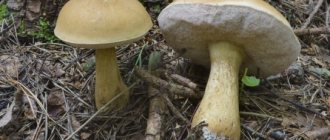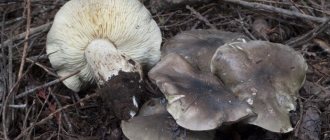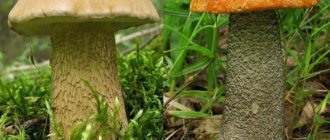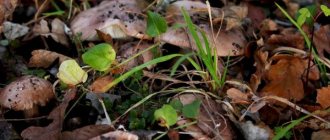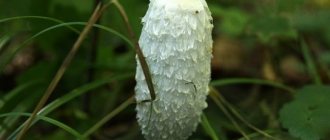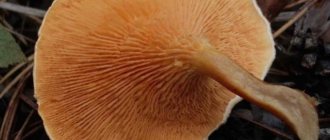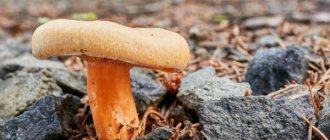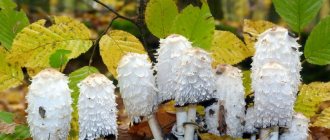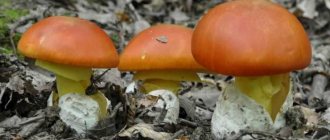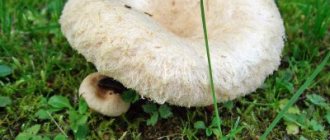Gall mushroom (also known as bitterling, also known as “false white”, etc.) is an inedible mushroom often found in our forests. Description and photo of gall fungus. Is bitterweed poisonous? About the medicinal properties of the mushroom and possible consumption
Hello dear reader!
The gall mushroom (Tylopilus felleus) is a very curious inhabitant of our forests. Its other common names are bitter and “false white.”
Bile mushroom
The mushroom is inedible because it is bitter. And the bitterness does not disappear with any boiling; rather, it even intensifies.
I won’t say that the gall fungus is very abundant on fruiting bodies. But sometimes it can occur quite often.
I won’t lie, for me the gall mushroom (gorchak) is most interesting... for the excitement it sometimes causes on the Internet. Especially during discussions that arise in “mushroom groups” on VKontakte and Facebook, and now also on Yandex Zen.
Here you find out that this is both a “terribly poisonous false white” and even that it is a “satanic mushroom” (naturally, also “terribly poisonous”). For some reason, it is the satanic mushroom that our “mushroom theorists” are especially afraid of. And even in Perm they are afraid of him!
This is both funny and sad.
What’s sad, first of all, is that people sometimes “compensate” for their ignorance, for which many are not entirely to blame, by being more aggressive towards those who do not support their point of view...
So, bittersweet (aka gall mushroom, also known as “false white”).
However, I’ll make a reservation right away. You need to pronounce and write “bilious” correctly. This is exactly what doctors say: “bile”, “gall bladder”, etc. Once upon a time, even the word was written with an “o”: “zholch”.
But many years of replacing “ё” with “e” in printing has led to the fact that in everyday life they often say “bilious”. Especially when using the word in a figurative sense: “bilious statement”, “bilious person”.
So I don’t see a big mistake in naming the fungus gall.
Appearance
The cap is up to 10 cm in diameter, initially convex, as it ages it becomes flat-convex, dry and smooth. Painted in brownish-brown tones.
The hymenophore is tubular-type, the tubes are initially white, then dirty pink. Spore powder is pink.
The leg is up to 7 cm long and up to 3 cm in diameter, club-shaped, has a creamy-ocher color and is covered with a dark mesh pattern.
The pulp is thick and soft, white in color, turning pink when cut. It has a rich mushroom smell, but is extremely bitter in taste.
Types of false porcini mushrooms
Nowadays, there are several edible species of mushrooms that have a number of similarities with bitterling, namely:
- porcini mushroom - has a convex cap and white, in some places reddish-brown, parts of the fruiting body. Lower plants are often used in cooking and have a mild taste and pleasant aroma;
- reticulated boletus - mushrooms have a hemispherical or convex cap, which is covered with a light skin. The leg may be brownish or light brown in color with a characteristic mesh pattern;
- boletus - the mushroom cap has not bright brownish shades; the flesh of the plant may be slightly colored when cut;
- bronze boletus - a fleshy, dense, spherical cap is characteristic of this type of lower plant. The leg has a red-brown color, cylindrical shape, thickened at the base.
There are also other types of mushrooms that are similar to mustard. That is why you need to purchase the product from trusted suppliers with special skills and many years of experience.
Where and when does it grow
Grows on sandy soils in coniferous and deciduous forests from June to October. Loves acidic fertile soils, often found near the roots of trees and on rotten stumps. Quite widespread, bears fruit both singly and in large groups. Insects and worms, as a rule, do not touch this mushroom for a very understandable reason. If you decide, for some reason, to collect bitter mushrooms, then do not put them in the basket with other mushrooms - they can spoil their pulp with bitterness. In general, it is better to use gloves when handling Gall Fungus.
Places where bitterling grows
The fungal population is found in coniferous, deciduous and mixed forests. It prefers to live in acidic or light soils, but can grow on dead wood or moss. Most often it grows on forest outskirts, along the edges of open forests near tree trunks.
We also recommend reading:
We collect and eat greenfinch mushrooms Varieties of row mushrooms: photos and descriptions Where to collect mushrooms: Krasnodar region is a great place for a quiet hunt Unique mushrooms of the Crimea
Usually bitterling grows solitarily, but there are also small colonies (5-15 pieces), so a bountiful harvest is a rare occurrence. Fertility begins in the middle of the summer season and continues until the autumn cold snap. In regions characterized by the onset of early and cold autumn, the lifespan of mushrooms decreases, ending in September.
Usually bitterling grows solitary
Edible or not
The gall mushroom is classified as inedible due to its extremely bitter taste. Moreover, after heat treatment, the degree of bitterness only increases.
In addition, according to research, the pulp of this mushroom contains toxins that destroy liver cells, so eating gall mushroom in large quantities can cause cirrhosis and other serious liver diseases.
It is believed that the harmful substances contained in bittersweet pulp can be absorbed into the blood even through tactile contact with it.
Minor dizziness, weakness, vomiting with the release of bile may appear on the first day after a person tries the mushroom “on the tongue”. These symptoms disappear quickly, but after a few weeks, problems with bile secretion may appear and signs of disruption of normal liver function may occur.
Unfortunately, there is still no accurate academic information about the effects of the toxins contained in bittersweet and the degree of their danger to humans, so the Gall Mushroom cannot be directly called poisonous.
Contraindications
Gall fungus poisoning is not fatal, but the consequences can still be quite unpleasant. Firstly, even prolonged boiling does not eliminate the specific taste. Secondly, the pulp contains toxins that lead to disruption of the gastrointestinal tract and destroy liver and kidney tissue. There are known cases when bitter bitter caused mild poisoning and severe digestive disorders - diarrhea, etc.
For cooking and medicinal (cosmetic) preparations, it is advisable to collect young specimens. Firstly, their taste is not so pungent, and secondly, they have more nutrients. In addition, “long-livers” accumulate more toxins, and the processes of aging and decomposition begin.
It is important to remember that the use of bittersweet is contraindicated for people prone to diseases of the digestive tract. It is better for such patients to refuse dishes made from bitter pulp and eat artificially grown fruiting bodies. They contain fewer saturated elements that irritate the digestive organs, cause allergic reactions, etc.
It is not advisable to give mushroom dishes to children under 10-14 years of age. They contain difficult-to-digest substances, such as chitin, etc. Not all adults, not to mention children, can eat it. People with chronic diseases are better off switching to safer foods.
Is it possible to eat bittersweet?
It is known that the flesh of the mushroom loses its bitterness after drying or soaking for a very long time in salt water, and some connoisseurs of mushroom cuisine believe that, neutralized in this way, the bitter taste is not inferior to boletus or boletus. In any case, it is obvious that eating bittersweet, taking into account all its features, must be done very carefully. In some ways, this mushroom is even useful - its pulp has anti-carcinogenic properties and contains useful amino acids and carbohydrates.
For all its features, bittersweet is, however, quite actively used in cooking both in the West and in the East. In France, it is boiled in milk, thereby eliminating the bitterness, and in China it is used as a seasoning - finely ground into powder. The main advantage of mustard is not the taste, but the rich mushroom smell.
There is a "devious" variety of the Gall Fungus called Tylopilus Felleus var. Alutarius. Its pulp is not bitter when raw, but when boiled it still appears in full force. This variety has an almost smooth stem, and the cap is painted in lighter shades.
Danger from the mushroom
If you eat a small amount of the product in question, poisoning is unlikely to occur immediately, except in cases of individual intolerance to such products. Moreover, in cases where bitterlings are preserved, confusing them with boletus mushrooms, a person who has eaten a lot of such products may get food poisoning . The fact is that in such treatments a preservative is used in the form of acetic acid - it masks the bitterness.
- Symptoms of poisoning are:
- nausea, vomiting, diarrhea;
- dizziness;
- impaired liver function that can be treated with medications.
Manifestations of damage by toxins may not reveal themselves immediately, but after several days . Such consequences of consuming the product can only occur if it is processed incorrectly.
Important! In extreme cases, with excessive consumption of bitters or when the gallbladder does not function properly, cirrhosis of the liver can develop.
The appearance of bitterling is similar to boletus and a number of other tubular mushrooms. This mushroom is classified as inedible, however, it is used in various cuisines around the world after pre-processing. In Russia, false boletus is also used as food and in folk medicine.
How to cook Gall Mushroom
Firstly, it is important not to accidentally put unidentified mustard in a pan with other mushrooms - its bitterness will ruin them all.
When boiled, it heavily stains the pan with the substances released from it, and this must be taken into account.
The best thing is to boil the mustards in milk, or first dry them, and then use the already dried fruiting bodies.
You can marinate the gall mushroom in vinegar, adding bay leaf and garlic. After several days in the marinade, the bitterness disappears completely. In Latin America, this mushroom is marinated with pepper, which makes the final product deadly spicy.
One of the simplest ways to combat bitterness is soaking: the fruiting bodies need to be cut into two parts and placed in a bath of warm water for 3 days, changing the water every 6 hours. After soaking, the bitterness will also disappear.
Growing
Many valuable mushrooms are grown in artificially created conditions, such as boletus, boletus and boletus. Not eaten, they can also be planted in garden beds and subsequently used for pharmaceutical purposes. But this does not apply to bitter. There is no point in purposefully growing a mushroom, and only gourmets or inexperienced mushroom pickers can collect this specimen in the forest for serving. Even in the absence of a decent harvest, you should not pay attention to the gall fungus.
Beginner mushroom hunters are advised to avoid false porcini mushrooms. It is not easy to prepare, there is a risk of poisoning, and the strong unpleasant taste will discourage you from eating bittersweet. These representatives of mushroom cultures can easily be confused with a white one because of the shape of the cap and a boletus because of its color. They are found in the same places. But some bright differences will help you identify the inedible false white and not bring this dubious trophy from the forest.
0
2
Copy link
Satanic Mushroom Boletus Satanas
Mushroom from the genus Borovik, family Boletaceae.
Appearance
The cap is up to 25-30 cm in diameter, hemispherical or rounded-pillow-shaped, smooth, dry or slightly velvety to the touch. The basic color of the cap is dirty gray, but it is prone to considerable variability - it can have various whitish-gray, yellowish or ocher shades, be olive-gray, have yellow-pink or greenish stains.
Tubular-type hymenophores - tubes are greenish-yellow in color, the pores in them are small, initially yellow, and with age they acquire orange-brown-red shades. They turn blue when pressed.
Spore powder is brown-olive.
The leg is up to 10 cm wide and up to 15 cm high. Initially spherical or ovoid in shape, then it becomes tuberous or barrel-shaped, with a narrowing in the upper part. In the central part the leg has a blood-red or orange-red color, in the upper part it is yellowish-red, and at the very base it has a brownish-yellow tint. The leg is covered with a peculiar mesh pattern with round-shaped cells, usually dark red, but sometimes olive or white.
The flesh is white or slightly yellowish in the cap, in the stem with a reddish tint. It turns red or blue when cut. In young fruiting bodies, the pulp has a faint spicy odor, but in old ones it smells very unpleasant - like rotten onions. The flesh tastes bitter.
Where and When It Grows
It grows from June to September in light deciduous forests, most often on calcareous soils. It forms mycorrhiza with linden, hornbeam, beech, oak, hazel and edible chestnut. In our country, its main distribution area is the Krasnodar Territory and the republics of the North Caucasus, but in the central part of the country it is difficult to detect.
Can it be eaten?
The mushroom is classified as an inedible or poisonous species due to the presence of the muscarine toxin and bitter taste. There are known cases of serious poisoning with this mushroom. Theoretically, this species can be eaten after a long soaking and preliminary boiling, but this is not safe for health.
Edible mushrooms: differences (video)
Another boletus double is considered to be the satanic mushroom. They really have a lot in common, because they belong to the same genus and family from the point of view of botanical classification.
At the same time, the poisonous twin has quite a lot of differences from the boletus, so if you are careful and carefully examine the picked specimen, you can easily distinguish the edible specimen from the poisonous twin (Figure 4).
The hat of the satanic species is velvety and quite large: in some specimens its diameter can reach 30 cm. As a rule, the skin is painted in light colors, from whitish and olive-gray to yellow-pink. The shade of the cap largely depends on the area where the mushroom grows and the intensity of light.
Figure 4. External features of the satanic mushroom
The stem of the satanic mushroom is wide and fleshy, but at the same time it has a very characteristic shade that is difficult to confuse with any other. It is red-yellow on top, red-orange in the center, and turns yellow-brown at the bottom. In combination with a light cap, the poisonous double looks really bright and immediately catches the eye, so it is quite difficult to confuse it with the inconspicuous boletus.
However, if you still cut a satanic mushroom and doubt its edibility, you can simply smell it. Unlike boletus, which has a pleasant mushroom aroma, satanic smells extremely unpleasant. If this sign doesn’t convince you, just cut it in half. When cut, the flesh will quickly begin to turn red and then turn blue, which never happens with boletus mushrooms.
Beautiful Boletus Caloboletus Calopus
A mushroom from the genus Kalobolet, family Boletaceae, also known as Boletus Inedible.
Appearance
The cap is up to 15 cm in diameter, initially semicircular, then convex, with a wavy and tucked edge. Painted in light brown or brownish-gray shades.
The hymenophore is tubular-type, the tubes have small rounded pores and are colored in grayish or lemon-yellow shades. They turn blue when pressed. The spore powder is brownish-olive.
The leg is up to 15 cm high and up to 4 cm thick, cylindrical or club-shaped. It has several tiers of coloring - at the base of the leg it is white, then brown-red, in the central part it is carmine red, with a noticeable reddish mesh, in the upper part it is lemon yellow, with a fine white mesh.
The pulp is dense and hard, light cream in color, turning blue when cut in the cap and the upper part of the stem. It has no distinct odor and is very bitter in taste, and this bitterness does not immediately appear on the tongue.
Where and when does it grow
It bears fruit from July to October under spruce trees, in coniferous and mixed forests, most often under spruce trees.
Can it be eaten?
The mushroom is considered inedible due to its extremely bitter taste. If it accidentally gets into the pan along with ordinary boletus mushrooms, it will spoil the entire dish with bitterness. Data on the presence of toxins in this mushroom have not yet been precisely confirmed, but there is information about cases of severe poisoning due to accidental consumption of this mushroom.
The gall fungus often causes trouble for inattentive hunters of forest mushroom riches, but this, of course, is not its fault. Every silent hunting enthusiast must know the signs that distinguish bittersweet from known edible mushrooms in order to detect it in time during forest searches and never encounter its legendary bitterness.
Varieties and lookalikes
According to their characteristics, bitterlings are similar in appearance to a large number of tubular specimens:
- white or boletus;
- greenfinch;
- boletus;
- champignon;
- loading;
- honey fungus;
- poisonous satanic mushroom.
Did you know? Fungi reproduce by spores. The record holder for the number of spores emitted is a raincoat - it spreads more than 7 trillion of these microparticles to a height above 2 m at a speed of 90 km/h.
The main feature that distinguishes bitterlings from their edible counterparts is the mesh on the stalk . Boletus, boletus, champignon and milk mushrooms have scales on their stems. The first grows mainly in deciduous forests, while bitterlings prefer coniferous forests. If we talk about greenfinches, they do not grow on the surface of the soil, but are hidden under its cover, at a depth of about 3 cm. Honey mushrooms are distinguished by smaller dimensions, a thin light brown leg smooth around the entire perimeter and a flat cap of a darker color. The satanic mushroom is distinguished by a thick stem, which is colored pink, while the bitter one is pale.
